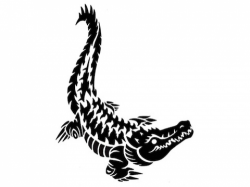What's the meaning of the Tiger »
Tiger
This page is about the meaning, origin and characteristic of the symbol, emblem, seal, sign, logo or flag: Tiger.

In parts of Asia, the tiger supplants the lion as the so-called “King of Beasts”. Its ferocity and majestic appearance have given it important symbolic meaning in cultures throughout the continent.
In the Chinese system of the cardinal directions - where four specific creatures guard the points of the compass - the tiger is associated with the West and the element of metal (sometimes this role is filled by the Ki-Lin, a mythical Chinese creature similar to a unicorn). A symbol of strength and courage, the tiger is closely associated with military prowess. As the third animal of the Chinese zodiac, people born during the Year of the Tiger are said to be brave and determined. Sometimes the tiger is paired with the Chinese dragon, representing Yin to the dragon's Yang (other times, Yin is represented by the Feng-Huang, or Chinese phoenix).
In Hinduism, tigers are associated with the deities Shiva and Durga, and the animal’s reputation for ferocity plays an important role in both cases. As the ultimate ascetic, or religious renunciant, Shiva is often portrayed either wearing a tiger skin or sitting on one. This symbolizes his conquest of the rampant appetites and desires that plague other beings. The fierce goddess Durga was created by other Hindu deities to destroy evil demons. In that capacity, she carries a different weapon in each of her ten hands and is often portrayed riding a tiger.
While the tiger's association with ferocity is plain for anyone to see, there is another, more complex side to their symbolic meaning. Despite their deadly reputation, or rather because of it, tigers are also key symbols of protection. Female tigers are extremely aggressive in defending their young, and in China, images of tigers are placed on graves. This is done in the hope of frightening off malevolent spirits who may want to harm the dead. In Buddhist belief, the tiger symbolizes senseless anger on the one hand, but is also seen as a creature of awareness and confidence, merging together the diverse symbolism associated with this mighty animal.
- 2,149 Views
Graphical characteristics:
Asymmetric, Open shape, Monochrome, Contains curved lines, Has no crossing lines.
Categories: Animal Symbolism, Chinese Symbols.
Tiger is part of the Buddhist Symbols, Hindu Symbols groups.
More symbols in Buddhist Symbols:
More symbols in Hindu Symbols:
More symbols in Animal Symbolism:
More symbols in Chinese Symbols:
China is one of the world's oldest and most long-lived cultures, with human settlement dating back to the Neolithic Era. Covering a vast region of eastern Asia, its many customs and traditions can va… read more »
Citation
Use the citation below to add this symbol to your bibliography:
Style:MLAChicagoAPA
"Tiger." Symbols.com. STANDS4 LLC, 2024. Web. 27 Jul 2024. <https://www.symbols.com/symbol/tiger>.

























Have a discussion about Tiger with the community:
Report Comment
We're doing our best to make sure our content is useful, accurate and safe.
If by any chance you spot an inappropriate comment while navigating through our website please use this form to let us know, and we'll take care of it shortly.
Attachment
You need to be logged in to favorite.
Log In